 The lure of the current occupant of the former Coca-Cola bottling plant in San Francisco brought me back for my third visit in a year-and-a-half. Here I was, again, at the processing facility for Goodwill of San Francisco, San Mateo and Marin Counties. The more I learn about the incredible ways this organization is serving the community at large, the more I want to help them shout it from the rooftop.
The lure of the current occupant of the former Coca-Cola bottling plant in San Francisco brought me back for my third visit in a year-and-a-half. Here I was, again, at the processing facility for Goodwill of San Francisco, San Mateo and Marin Counties. The more I learn about the incredible ways this organization is serving the community at large, the more I want to help them shout it from the rooftop.
This time the majority of my visit was as far from the roof as you could get. There in the basement – once the restroom, locker room, and shower for the plant workers – lives the department of e-commerce. What brought me here was books, and a desire to explore another piece of the recycling puzzle. (Read about my previous visit when I explored and documented textile recycling at this facility.) For here is a place where you can recycle encyclopedias, textbooks, novels, dictionaries, how-to books…you name it!
My enthusiastic and insightful guide was Johnny, e-Commerce Manager extraordinaire. We started the tour in his cubicle, a standard-issue work space in one of the many rooms that houses the physical manifestations of Goodwill’s online presence. There on his computer screen was the face of the electronic master behind the curtain – the powerful software that enables the staff to manage every aspect of inventory, shipping, and beyond.
“More people are buying books online than in stores these days, so our inventory can be seen by millions of people at a time,” he explained when speaking about the main benefit of investing human, spatial, and financial resources into this branch of the enterprise. He walked me through various screen displays and the ways they set up parameters or “rules” to determine where a book will be sold. Goodwill is a vendor on Amazon, e-Bay, AbeBooks, Alibris, and half.com.
Up until four years ago, most books received at Goodwill went to a salvage vendor. There was no infrastructure then to support what happens now. The range of merchandise they sell online is diverse and growing each day. DVD and CD sales are included in the monthly sales totals with the books. A lot has changed in a short time.
What does this look like? Four years ago, Goodwill sold 10-20 books per day online. Today, that number is anywhere from 500-1000 books online each day. Sales used to be limited to within the U.S., and when they decided to offer international shipping, sales increased by 15% . In March 2010 alone, this department in the basement sold 20,000 books, DVDs, and CDs. Springtime usually shows a downward trend, and in April, online totals were near 18,000 books, DVDs and CDs sold. Even with a slight dip, it’s pretty darn impressive!
OVERVIEW OF THE FLOW
A book’s sales rank on Amazon is a primary determining factor of how fast a book will sell. Incoming books with good sales ranks will be diverted to e-commerce for processing in order to be sold online. Others will be triaged for either the retail stores or salvage vendors.
How do the books turn into sales? When book are received in the warehouse, each and every one of them is processed. All books with a barcode are scanned to determine their “street value.”
While waiting for the computer to bring up the sales rank, a Goodwill employee will examine the overall condition of a book to make sure it is acceptable for e-commerce. Should a red bar appear across the bottom of the screen, the book is to be rejected. If no red bar, the book gets put in a bin and sent to the basement for further processing.
Because of the sheer volume of books coming through the doors, and finite space in which to store and process them, books have a limited time in the system. Here’s an overview of their life-cycle:
- e-Commerce – Books will stay in e-commerce for 90 days. If after 90 days, they have not sold, they will go through the same process as retail-destined books: As-Is Store, then salvage.
- Retail – Books that end up on the shelves in the local stores are not appropriate for e-commerce. These could be lightly damaged books, leather-bound older books that have no bar codes but will be a happy find for a treasure-seeker, etc. In general, these books have a 30-day cycle in a store before they rotate out to the As-Is Store.
- As-is Store – Located in on the main floor of the processing facility, this area is the final stop for anything to be sold by Goodwill to the public before going to salvage.
- Salvage vendors – Salvage vendors purchase all unsold books in bulk and sell them through their respective networks. Encyclopedias and dictionaries are among the books that go directly in the bins for salvage.
Johnny and I were ready to leave the computer behind and stroll through the processes in e-commerce land. Before stepping away from the cubicle, we were momentarily sidetracked by two quotes he keeps on a whiteboard hanging to one side. Both were by Frank Herbert, author of Dune, and one spoke volumes to me:
“A process cannot be understood by stopping it. Understanding must move with the flow of the process, must join it and flow with it.”
It was then that I learned a new word: kaizen. In a broad sense, kaizen is about eliminating waste and inefficiencies while improving systems. Johnny told me about the weekly department team meeting, called a “kaizen event,” that he holds with his staff. The input and exchanges of team members during these sessions have led to improvements to the way the department does things. Like the Herbert quote says, it’s a process. Big and small, the changes have added up: together, they have doubled the department’s volume of production while increasing incoming-generating potential. Kaizen goes deeper, too, into the humanity of the workplace, and the individuals who partake. From what little I read about it thus far, it’s a beautiful philosophy and practice.
THE BASEMENT
Leaving the shielded calm of the cubicle and main office area, it was hard to ignore the fact that merchandise and supplies were shelved, stacked, and/or being carted through every corridor, repurposed room, nook and cranny of the basement. Space is at a premium, and I was awed by the ways they are able to make the finite and awkward spaces work.

Books destined for sale online come downstairs from the warehouse in red bins. Here, staff scan books into the system.
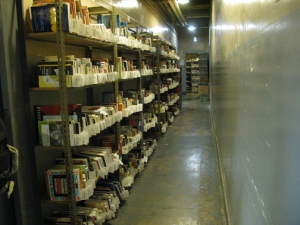
The shelves of e-commerce hold up to 35,000 units. The main corridor through the basement is lined with books. If it was wider, the other wall would be lined, too!

A round sink basin in the former locker room has been covered with wood to create a work surface. And it’s surrounded by…books!

A sink in a bathroom that is no longer used as a bathroom is covered by a table that serves as a shipping desk. In the far corner, a machine that repairs the CDs and DVDs that get sold. In the mirror, a reflection of my tour guide.
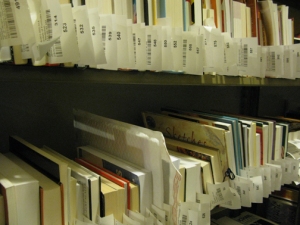
Each book has a precise location – bay, shelf, and book number. Every morning, packing slips print out in the order in which books are stored on the shelves. This is only the tip of the iceberg of a super efficient system!

The expansion of e-commerce into the garage is a sign of its growth, and the growing pains. Approximately 100 mail bags of presorted media mail leave this facility each day! In this photo, staff sort packages into mail bags in bins. There is one bin for each of the 21 major mail hubs in the U.S.
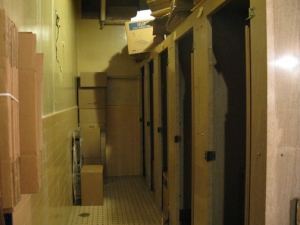
The five toilet stalls – with their original fixtures intact – are filled with boxes of bubble wrap mailers. Beginning in July, this department will be minimizing its environmental impact when they switch to biodegradable bags. These bags come in rolls and will occupy far less space than the bubbles now do.
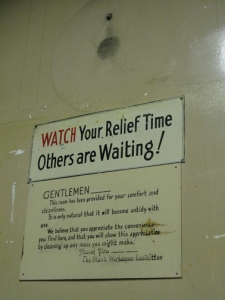
In the bowels of the building, you can see literal signs of how this repurposed space used to cater to actual, um, bowels.
THE re-CYCLE GETS AN INFUSION
This year, Goodwill began the launch a unique collaboration called the Sustainable Schools Partnership. Through this new donation program, a school can collect books, videogames, CDs and DVDs. In return, they will receive a percentage of the revenue raised from the sale of these goods through the online stores. It’s a win-win for everyone. In these financially challenging times, local schools have a new fundraising opportunity. Children, teachers, and parents can help the community by educating others about this beneficial new recycling program. Local residents have an incentive to sort through their personal libraries and move the cumbersome and heavy piles of books out of the house and into the hands of two good causes.
As you can see, Goodwill continues to be a value recovery enterprise in every sense of the term. They uncover the value in people (nearly 500 people work for Goodwill in San Francisco, San Mateo and Marin counties) and continue to train, employ and empower this workforce. They uncover the value of community by providing the infrastructure and implementation of programs so we can all participate and do the right thing. They uncover the value in products and have become one of the biggest pieces of the recycling chain in the Bay Area. Last year, Goodwill kept more than 880,00 books and media from heading to landfill. Imagine how much more could be diverted with the implementation of this school endeavor and whatever else is up their recycled sleeves.
Somehow all this makes sense. And it puts cents in the right pockets.


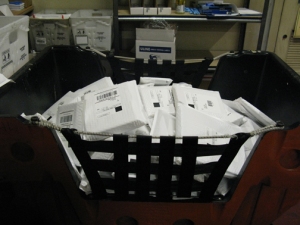
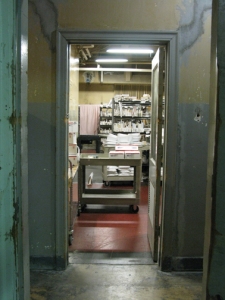



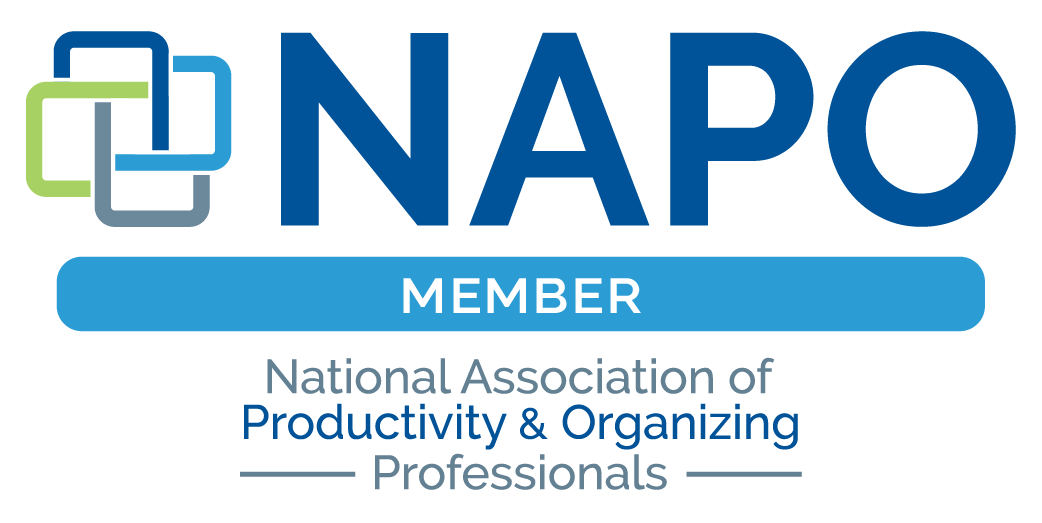


I had no idea of this. My favorite independent bookstore has sadly closed down (Stacy’s). But I’m glad to learn that Goodwill still leaves me with a great option!
Gina, Stacy’s was one of my favorites, too, but we are so very lucky to have (still!) lots of other fine neighborhood bookstore options in this town.
And to think that we have this other brilliant alternative in Goodwill. Books (like any other donation) provide the revenue that in turn generates opportunity and vital life and work skills training to those individuals enrolled in their programs. It’s win-win for everyone!
Thanks for sharing your fascinating and information-filled tour with us! Many of our clients find it easier to part with their excess if they know it’s going to a good cause and not to landfill.
Information and education is empowerment – for our clients and ourselves. The more ALL of us know, the better informed our choices become.
Great post Debra! I can’t wait to visit now!
Erin
Thanks, Erin! I hope you perused my other post about textile recycling at Goodwill: http://liberatedspaces.wordpress.com/2010/02/19/goodwill-not-landfill/
Gina, is the Green Apple still there?
Eric, Green Apple IS still there on Clement. Thank goodness for them and a handful of other independent bookstores that continue to flourish!